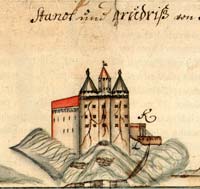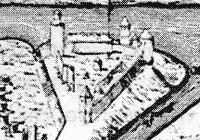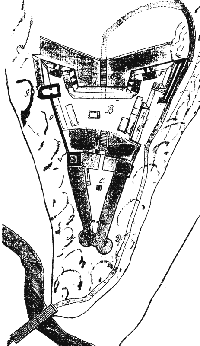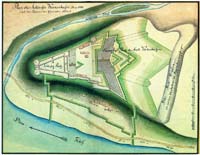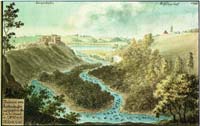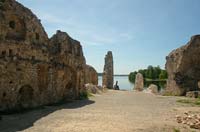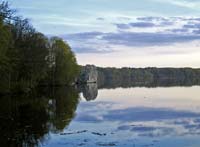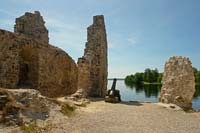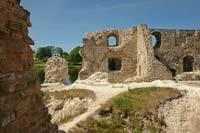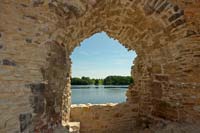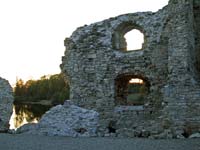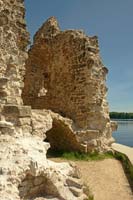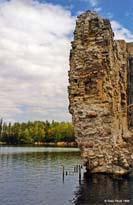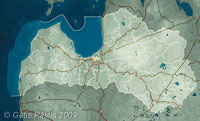
| Coordinates: | 56° 38'17,0'' N 25° 25'03,0'' E Google Maps |
| No: | 12 (full list of landmarks) |
| Category: | Medieval castles, Palaces and manor houses |
| Address: | (Aizkraukle district), Koknese region, Koknese municipality, Koknese park, junction of Perse and Daugava rivers |
| Year of construction: | Shortly after 1209 |
| Condition: | Ruins, partly conserved |
| Values: | Architecture, archaeology |
| Conservation status: | Archaeology monument of state importance No.118 (together with the medieval town), architecture monument of state importance No.6160. |
More on medieval castles:
- 12 most interesting medieval castles in Latvia
- History of medieval castles
- Complete list of Latvian medieval castles
- Location of medieval castles in Latvia
Brief description
One of the largest an most important medieval castles in area of Latvia was Koknese castle. Before the construction of the castle in the picturesque, 30 metres high, wedge-shaped hill between Perse and Daugava rivers there was a hillfort of Latgallians. Construction of the castle of Archbishopric of Riga here was started in 1209 - in short time here rised enormous castle with forepart and the fortified Koknese town nearby.
Koknese castle was abandoned after detonation of the imposing western towers in 1701. Nowadays there remain impressive ruins. After the creation of Plavinas hydropowerplant lake the water reached the fundament of Koknese castle - thus ruins are endangered now and are fixed with concrete constructions below the water level. In spite of this these ruins are some of the most picturesque castle runs in Latvia.
Other names, origin of name
In German the most often used name is - Kokenhusen, more ancient name - castrum Kukonois (1211). Name has got numerous other versions - Kocanois, Kukonoys, Kukennoys, Cocanis, Cokenhuzen, Kakenhuszen, Kokenhausi and others.
History
Medieval times
Koknese castle has been built on older hillfort of Latgallians - before the construction of the castle here was governing Vetseke. In the occupation layer of the castle there are 14 sub-layers. Eight of these layers belong to prehistoric times - times before the construction of the castle. Koknese is mentioned first in the Chronicle of Henry of Livonia - this document is mentioning the arrival of Vetseke to the bishop Albert in 1205. In 1207 Vetseke presented half of the castle an half of his lands to Archbishopric and thus became a vassal of bishop. Already in 1208 Daniel from Lennewarden (Lielvarde) attacked Koknese in bad faith and captured Vetseke. Bishop of Riga ordered to release him and to give presents, there were sent 20 warriors to Koknese and masons to fortify the castle. Vetseke in turn attacked the Germans, killed most of them, burned down his castle and departed to Novgorod.
Bishop Albert ordered to build a well fortified castle in Koknese in 1209. One third of the castle was allocated for Livonian Brothers of the Sword, two thirds were given as a fiefdom to knight Rudolph von Jerichow. Bishop and Brothers of Sword did not govern here long. Part of Koknese which belonged to Brothers of Sword was exchanged to Autine lands (north, at Gauja river) in 1213 and thus bishop was the only owner of Koknese. In 1221 liege of Koknese Dietrich defeated 600 Lithuanian pillagers near the castle. Hans Tiesenhausen obtained the castle in 1269 either through marriage with the widow of Dietrich or through purchase of the inheritance right. Tiesenhausens governed in the castle until 1397 - in this year archbishop John V von Wallenrodt took over the control of the castle. Since then the castle was governed by a vogt who was directly appointed by archbishop. Koknese castle was one of three main castles of Archbishopric of Riga - each summer archbishop moved over to the castle with his court.
During the first quarter of 15th century, in times of archbishop Henning Scharpenberg the castle was rebuilt, there was built also the largest tower - Long Henning.
In 1479 Koknese castle served as a prison for archbishop Silvester Stodewescher captured by master of Livonian order Bernd von der Borch. Similar events took place in 1556 - master of Livonian order Johann Wilhelm von Fürstenberg captured and inprisoned in the castle the last medieval archbishop of Riga Wilhelm von Brandenburg.
Already in 13th century there was developing a settlement next to Koknese castle. In 1277 archbishop Johannes I von Lune granted rights of town to Koknese. In this document there has been mentioned also the defensive wall of the town - this means that a town existed here earlier as well. Stamp of Koknese is known since 1345 - it depicts a bust of St. Paul. Starting from 1326 several times there has been mentioned St. Paul's church in Koknese. Town was also a member of Hanseatic League. Main income was from customs - along the town there were floating numerous rafts and ships loaded with goods.
Castle and town became part of Poland after the collapse of Livonian state. In 1577 Koknese - also the castle - was taken by troops of Russian tsar Ivan the Terrible - but later Poles managed to get it back.
17th -19th centuries
In the beginning of 17th century the castle several times was captured by Poles and Swedes. In 1621 the castle was captured after 16 days long siege by king of Sweden Gustav II Adolphus. In 1636 Koknese was declared to be a centre of district importance next to three other disctrict centres - Riga, Tartu and Parnu. In 1656 castle was captured by Alexei Mikhailovich and Russians renamed Koknese to Dmitrij. Here were erected the main storehouses of Russian export goods. Already in 1656 Koknese was taken by Swedes again.
After the numerous wars of 17th century Koknese town declined. After the establishment of nearby Jaunjelgava river port Koknese lost also its importance as a transit centre. In 1700, during the Great Northern War the castle was taken by Polish-Saxonian trops. After the lost Spilve battle Saxon colonel Adam Heinrich Bohse ordered to blow up both western towers of the castle. This took place in 25th July 1701, early in the morning. Since then the castle is not inhabited anymore and also the medieval town was abandoned.
In 1744 the castle was granted to count Shuvalov. In 1780 it was purchased by Otto von Levenstern - his family owned the ruins of the castle until 1920. In vicinities of the ruins in Koknese park there was built a new palace. Koknese castle ruins became a belowed tourist destination already in the end of 19th century.
20th - 21st centuries
During the First World War the ruins were located on front-line but the thick walls did not suffer much.
When Plavinas hydropower station was built, the lake of station rised up to the fundament of the castle and wawes started to wash it out. Since 1990ies the castle is reinforced - under the medium water level there is built a protective belt of concrete. At the same time there is ongoing unearthing of the inner part of castle and conservation.
Description of the construction
Outward fortifications
Castle is built on natural heights which once, before the construction of hydropower station were rising 30 metres above Daugava. Hill is located at the mouth of Perse River - it flows in Daugava here. Castle itself took 0,2 hectares, forepart of the castle was 0,4 ha large and medieval town - 3,6 ha large.
Between the castle and the forecastle there was a dry moat, both ends were sealed with defensive walls. Forepart of the castle was protected with walls from three sides, there was no wall only towards the castle. Between the forepart of the castle and the castle there was another dry moat. Access to the castle and forepart of the castle was protected with drawbridges.
From the town one could enter the forepart of the castle through the gate tower closer to Perse. Entrances in towers were protected with drop-bars.
Koknese town was protected with a defensive wall as well.
In 17th century there were created also earthen ramparts around the castle - in some places they covered also more ancient buildings.
Build of the castle
Koknese stone castle was intensely used approximately 500 years long. During this long time it was rebuilt several times, renewed and supplemented with newer buildings. Thus it is not possible to imagine the outlook of the castle in 13th-14th century from the drawings created in 17th century. Unfortunately materials from the excavations of 1960-1961 have not been compiled and published, there have not been compiled also all the available sources about the construction history of the castle. Thus we can get only limited understanding about the outlook of the late medieval castle through the use of castle revision protocols from 1590 and 1599 and plans and drawings from 17th century.
In these times the main part of Koknese castle consisted of two blocks - one was located along Daugava bank, another - along Perse. Both blocks had two apartment floors and third - armoury floor in the attic. Castle was built from dolostone which was mined in Daugava outcrops nearby. There were used bricks for windowsills, door openings and valves. Thickness of outer walls was 3,8 - 4 metres, inner walls (towards the inner courtyard) - 2 - 2,5 metres.
Koknese castle had five towers. Two massive towers and smaller tower among them were directed as enormous forepart of ship towards southwest, heading down the Daugava stream. Another - the longest tower was named Long Henning after one archbishop of Riga (see above in history). Two more towers were located on both corners of the eastern side of the castle. In the basement of both large western towers there was a prison.
In the block which was located along Perse there was large brewery, bakery and kitchen. In the block along the Daugava there was a mill which was powered by horses. In second floor there were apartments and meeting rooms. At the side of Perse there was a dining hall and closer to the western tower - chapel with three windows towards the inner yard.
Already in the 16th century windows of the castle had glass panes. Second floor was heated with tile stoves and fireplaces. In the centre of inner yard there was a well - it was hewn out in the cliff and laid out with masonry.
In the forepart of the castle there were located apartments of servants, forge, granary and stabling.
Up to this day there have been preserved impressive ruins. Up to the height of two floors there have been preserved outer walls along Perse and Daugava, also part of the inner walls has been preserved. There is no trace left of the mighty western towers which were blown up in 1701. Other premises of the castle are covered with thick layer of ruins and cultural layer, in some places up to 7 metres thick.
Monuments of art and other interesting details
In the walls of the castle and in layer of ruins there have survived numerous constructive details of stone but these have not been evaluated and dated. Thus, f.e. there are diverse views on the age of the stone windowsills directed towards Daugava - V.Neimanis and A.Tuulse consider that these belong to Romanic style, R.Malvess and I.Stukmanis consider that they represent the much younger Rennaisance style.
...
A.Stubavs in excavations from 1961 - 1966 found remnants of the prehistoric wooden castle under the stone castle - but in this ancient layer there were found also remnants of masonry. Thus A.Stubavs considered that this monument is the oldest masonry building in Eastern Baltic. There was found also a shiver of bronze bell at this fragment of masonry.
Legends
When the castle was built for the limewash there was used milk instead of water. It has to be supplied by nearby farmers. (2)
...
In one of the cellars of Koknese castle there is kept old money collected by Devil. He is guarding it himself, reposing on a chest as a small black dog or snake. (2)
...
Once daughter of the lord of the castle fell in love with the gardener of the castle. When lord of the castle heard that she wants to marry an ordinary gardener, he ordered to imprison her in the highest tower of the castle. As the gardener still was in love with the unhappy girl and refused to forget about marriage with her, lord of the castle odered to kill him. He was killed in sight of the girl - when she saw it, she jumped out of the tower and was dead. Later she has been seen many times sitting on the bank of Perse and combing her hair. If somebody came closer, she disappeared. If somebody saw her and run away, she was running after in vain hope that she has seen her beloved gardener. (2)
Other images
Investigations
- 1792 - K.G.Grass, drawing for the collection of J.C.Brotze, includes also drawing of ruins from 1796 and 1797, copies of older drawings;
- around 1828 - V.Tush, plan of ruins for album of Pauluci;
- 1839 - F.Kruhse, chart of the plan of castle;
- 1899 - K.Löwis of Menar, drawing of the chart of castle, description of ruins;
- 1961 - 1963 - T.Ciparsons - photo fixation and R.Malvess, beginning of archaeological excavations, compilation of historical data about the old pictures of Koknese medieval town;
- 1961 - 1966 - A.Stubavs, archaeological excavations in the castle, forepart of the castle and medieval town of Koknese;
- 1986 - 1989 - I.Zeiere, archaeological excavations;
- 1991 - 2000 - M.Rusa, unearthing of the upper part of the walls, I.Stukmanis, fixation of architecture and elaboration of conservation project.
Linked landmarks
- Koknese hillfort and ancient town
- Koknese park
- Stone crosses in Koknese park
- Cannons in Koknese park
- Perse waterfall (lost)
- Perse small waterfall (lost)
- Remnants of Koknese manor palace
References
- Caune A., Ose I. Latvijas 12. gadsimta beigu - 17. gadsimta vācu piļu leksikons. Rīga, 2004.
- Plaudis A. Ceļvedis pa teiksmu pilīm. Rīga, 2004.
- Ruša M. Arheoloģiskie izrakumi Kokneses pilī. Zinātniskās atskaites sesijas materiāli par arheologu 1994. un 1995. gada pētījumu rezultātiem. Rīga, 1996
- Website of State Heritage Inspection http://www.mantojums.lv, accessed in 21st December 2008


